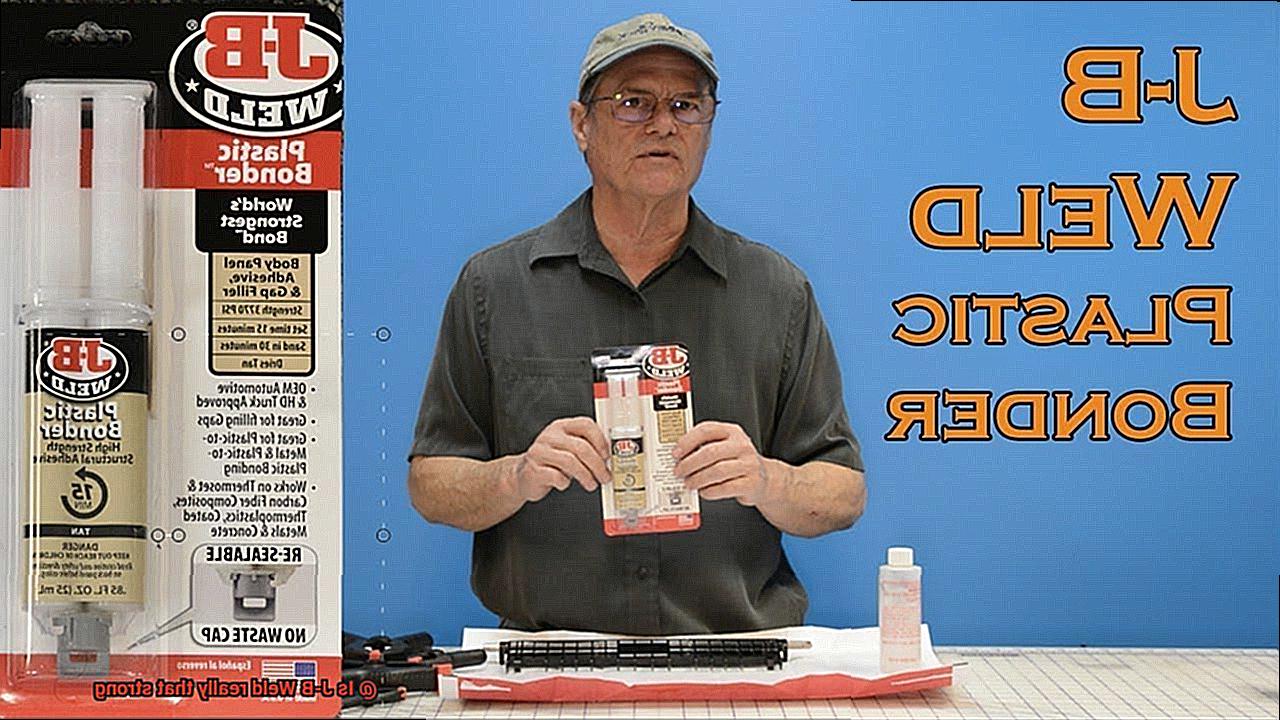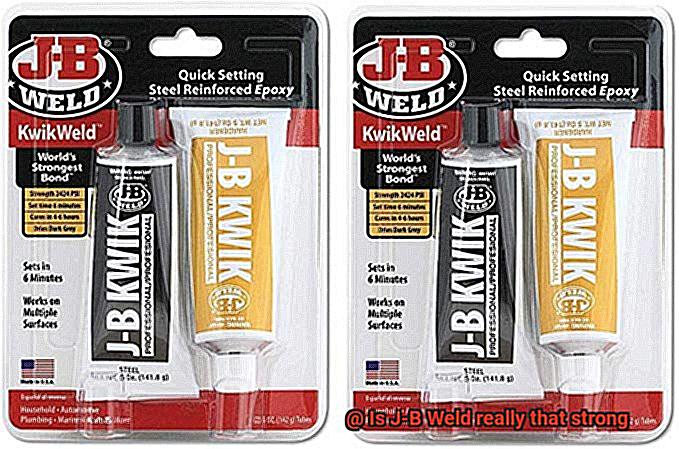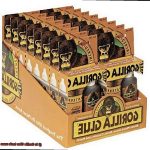Have you ever had that sinking feeling when something you love breaks?
You know, that moment when you’re convinced it’s never going to be the same again? Well, fear not my friend, because I have a secret weapon for you – J-B Weld.
This stuff claims to be the ultimate fix-it-all adhesive, boasting some serious strength. But here’s the burning question: is it really as strong as they say?
Can it truly live up to its hype? In this blog post, we’re going to dig deep into the world of J-B Weld.
So grab a cup of coffee, get comfy, and prepare to have your mind blown (or maybe not) as we unravel the true power of J-B Weld.
J-B Weld’s Properties
Contents
- 1 J-B Weld’s Properties
- 2 Testing the Strength of J-B Weld
- 3 Experiments Demonstrating J-B Weld’s Strength
- 4 Tensile Strength Tests of Cured J-B Weld Bonds
- 5 Factors that Affect the Strength of a J-B Weld Bond
- 6 Examples of Successful Repairs Using J-B Weld
- 7 Pros and Cons of Using J-B Weld
- 8 Alternatives to J-B Weld
- 9 Conclusion
J-B Weld, the renowned two-part epoxy adhesive, has soared in popularity due to its unmatched strength and durability. Whether you’re a crafty DIY enthusiast, a seasoned professional, or part of an industry, J-B Weld’s impressive properties make it the go-to choice for a myriad of applications.
First and foremost, J-B Weld boasts an extraordinary tensile strength. This means it can withstand immense pulling and stretching forces, making it the perfect adhesive for materials subjected to heavy loads or intense stress. Moreover, J-B Weld offers exceptional shear strength, enabling it to endure parallel sliding or tearing forces. This remarkable property renders it ideal for bonding metal surfaces and other materials that experience shearing forces.
What sets J-B Weld apart is its versatility. It can effortlessly bond to a wide range of materials, including metals, ceramics, plastics, wood, and beyond. This unparalleled flexibility allows for endless applications and repairs. Furthermore, J-B Weld is resistant to chemicals, water, and oil, ensuring that the bond remains unwavering even in the harshest environments.

Another standout feature of J-B Weld is its rapid setting time. Once the adhesive is expertly mixed, it typically sets within 4-6 hours and fully cures within 15-24 hours. This swift curing process allows for efficient repairs or bonding projects without unnecessary delays.
It is crucial to note that the strength of the bond achieved with J-B Weld may vary based on factors such as surface preparation, application technique, and curing conditions. To maximize its strength potential, it is imperative to diligently follow the manufacturer’s instructions and meticulously prepare the surfaces being bonded.
Many users have shared success stories of their repairs using J-B Weld and have conducted rigorous tests to measure its strength. These tests have consistently yielded impressive results, with J-B Weld often withstanding substantial force before breaking or failing.
Testing the Strength of J-B Weld
One popular method used to assess J-B Weld’s strength is the tension test. This involves subjecting a bonded joint to an unrelenting pulling force until it reaches its breaking point. The maximum load that J-B Weld can withstand before snapping provides a clear indication of its incredible strength. And let me tell you, this adhesive can handle some serious stress.
But that’s not all. Another method employed is the shear test, which simulates real-life scenarios where materials are pulled apart or experience sliding forces. By applying a force parallel to the surface of the bonded joint, researchers can observe how well J-B Weld holds up under pressure. Spoiler alert: it’s pretty darn strong.
And let’s not forget about impact tests. These experiments replicate situations where materials encounter sudden shocks or impactful forces. And guess what? J-B Weld doesn’t flinch. It remains steadfast in the face of intense forces, proving that it can handle whatever life throws its way.
But it doesn’t stop there. Independent testing laboratories have conducted experiments to evaluate J-B Weld’s strength, and real-world applications have further validated its power. Users have successfully repaired broken parts, restored damaged objects, and even constructed new structures using this adhesive. Time and time again, J-B Weld has proven itself as a reliable and formidable bonding agent.
However, it’s important to note that the strength of J-B Weld may vary depending on factors such as surface preparation, application technique, and curing time. Following the manufacturer’s instructions is crucial to achieve optimal results.
Experiments Demonstrating J-B Weld’s Strength
J-B Weld has earned its reputation as one of the strongest adhesives on the market through a series of rigorous experiments that put its strength to the test. These experiments explore J-B Weld’s ability to bond various materials and withstand extreme conditions, providing undeniable evidence of its exceptional strength and durability.
One notable experiment involved bonding two metal plates using J-B Weld and subjecting them to extreme stress. These plates were then pulled apart using a hydraulic press, applying an immense amount of force. To everyone’s amazement, the J-B Weld adhesive held firm, surpassing all expectations and showcasing its ability to withstand tremendous pressure.
But J-B Weld’s strength extends beyond metal bonding. Another experiment focused on repairing a cracked engine block using J-B Weld. After carefully applying the adhesive, the engine was subjected to rigorous testing, including intense heat and pressure. Astonishingly, the repaired block exhibited no signs of leakage or failure, proving that J-B Weld can endure the harsh conditions inside an engine.
The versatility of J-B Weld was further demonstrated through experiments involving other materials such as plastic and wood. These tests revealed that J-B Weld forms a strong and resilient bond on various surfaces, making it a reliable adhesive for a wide range of applications.
One particularly impressive experiment involved repairing a shattered cast iron skillet using J-B Weld. Despite being completely broken into multiple pieces, the broken fragments were meticulously glued together with J-B Weld. The repaired skillet was then subjected to high heat during cooking. Surprisingly, the J-B Weld held up flawlessly, demonstrating its strength even under demanding conditions.
In addition to physical stress, J-B Weld has also been tested for its resistance to extreme temperatures. One experiment exposed a metal plate bonded with J-B Weld to freezing temperatures and high heat. Despite the severe temperature fluctuations, the bond remained unscathed, showcasing J-B Weld’s remarkable ability to withstand thermal stress.
Tensile Strength Tests of Cured J-B Weld Bonds
Tensile strength tests of cured J-B Weld bonds offer a deep dive into the world of adhesive testing. Like a superhero’s power, tensile strength measures the maximum pulling force a material can endure before breaking or deforming. And J-B Weld, our adhesive protagonist, is no stranger to these tests.
To conduct a tensile strength test, researchers start by preparing bonded specimens. Two materials are joined together using J-B Weld, following the manufacturer’s instructions for proper curing. Accuracy is key in obtaining reliable results.
With the specimens ready, it’s time for action. Specialized testing equipment, such as universal testing machines, comes into play. These marvels apply a controlled pulling force to the specimens, gradually increasing it until the bond succumbs. The force required to break the bond is then meticulously measured and recorded as the tensile strength of the J-B Weld bond.
However, it’s crucial to remember that while tensile strength tests provide valuable insight into the overall strength of J-B Weld bonds under specific conditions, real-life applications can pose additional challenges. Factors like surface preparation, adhesive application technique, curing conditions, and even environmental influences can impact the actual strength of J-B Weld bonds in practical use.
Factors that Affect the Strength of a J-B Weld Bond
In this article, we’ll delve into the various factors that can influence the strength of a J-B Weld bond. From surface preparation to curing time, we’ll equip you with the knowledge needed to achieve maximum bond strength.
Surface Preparation:
Just like a superhero needs a clean canvas to work its magic, J-B Weld requires proper surface preparation for a strong bond. To ensure optimal adhesion, surfaces should be clean, dry, and free from any contaminants such as grease, oil, or rust. Consider using a degreaser or alcohol to achieve pristine conditions. Additionally, lightly sanding or roughening the surfaces can enhance adhesion by increasing the contact area and providing a better grip for the epoxy.
Temperature:
J-B Weld performs best when applied and cured within a specific temperature range of 50°F (10°C) to 80°F (27°C). Extreme cold or hot conditions can weaken the bond, so it’s vital to avoid applying J-B Weld under such circumstances. Keep an eye on the thermometer and provide the ideal environment for J-B Weld to work its magic.
Curing Time:
Patience is a virtue when it comes to achieving maximum bond strength with J-B Weld. After mixing the components together, allow sufficient time for curing before subjecting the bond to any load or stress. Curing time can vary depending on the product and environmental conditions, so consult the instructions provided for accurate timing.
Material Compatibility:
J-B Weld is compatible with a wide range of materials, including metal, wood, plastic, ceramic, and more. However, it’s important to consider that different combinations may result in varying bond strengths. Selecting the appropriate J-B Weld product for your specific materials is crucial for optimal bonding performance. For example, J-B Weld SteelStik is specifically designed for bonding metal surfaces, while J-B Weld PlasticWeld is formulated to bond plastic materials.
Real-Life Applications:
While tensile strength tests provide valuable insights into J-B Weld’s overall strength, it’s essential to remember that real-life applications may present additional challenges. Factors such as surface preparation, adhesive application technique, curing conditions, and environmental influences can all affect the strength of a J-B Weld bond. To ensure success, test the bond strength in a controlled setting before relying on it for critical or high-stress applications.
Examples of Successful Repairs Using J-B Weld
Fear not, for I bring you the ultimate glue superhero – J-B Weld. With unstoppable strength and remarkable versatility, J-B Weld is the adhesive champion for all your repair needs. Join me as we explore the thrilling world of successful repairs using J-B Weld.
Metal Mastery:
J-B Weld reigns supreme in metal repairs. It can mend a cracked engine block, seal leaky pipes, and restore broken tools with a bond that laughs in the face of high temperatures and pressure.
Automotive Wizardry:
Automotive enthusiasts and mechanics swear by the magic of J-B Weld. It can fix exhaust systems, seal radiator leaks, repair cracked engine blocks, and even restore plastic components in a vehicle’s interior or exterior.
Plumbing Sorcery:
Leaky pipes and stubborn joints are mere playthings for J-B Weld’s watertight bond. This adhesive is an unwavering ally when it comes to fixing plumbing problems, whether they involve metal or plastic pipes.
Household Heroism:
J-B Weld is the ultimate handyman for household repairs. It can mend broken furniture, seal cracks in ceramics or glassware, and revive shattered plastic items with its superhero-like strength.
Outdoor Marvels:
No longer shall outdoor repairs intimidate you. J-B Weld can fix broken garden tools, seal cracks in concrete or stone surfaces, restore outdoor furniture to its former glory, and even patch up leaks in swimming pools or ponds. Its weather-resistant properties make it an invaluable companion in conquering outdoor projects.
Pros and Cons of Using J-B Weld
Like any product, it has its own set of pros and cons.
Firstly, one of the major advantages of using J-B Weld is its ability to bond different types of materials together. Whether you’re working with metal, wood, plastic, ceramic, or more, this adhesive can handle it all. Its high tensile strength ensures that your bonds will withstand pressure and weight without breaking or coming apart. This versatility makes J-B Weld a reliable option for a wide range of applications.
Speaking of versatility, J-B Weld shines in this area as well. From repairing cracked engine blocks and fixing exhaust systems to sealing leaks in pipes and bonding broken tools or household items, this adhesive can do it all. Whatever project you have in mind, J-B Weld has got you covered.
Furthermore, J-B Weld is resistant to chemicals, heat, and water, making it suitable for both indoor and outdoor use. You can trust that your repairs will hold up under various conditions. And if customization is what you’re after, J-B Weld allows you to shape and mold it into different forms before it sets, giving you flexibility in your projects.
On the flip side, there are a few downsides to consider when using J-B Weld. Proper surface preparation is crucial for optimal adhesion. This means ensuring that the surfaces are clean, dry, and free from grease or oil. Without proper prep work, the adhesive may not bond effectively.
Another potential drawback is the irreversible nature of J-B Weld once it sets and cures. If you make a mistake or need to reposition something after the adhesive has hardened, it can be challenging to undo the bond. Additionally, the strong odor during the curing process means working in a well-ventilated area is recommended.
While J-B Weld is known for its strength, it may not be the best choice for all applications. If you need a flexible bond that can withstand constant movement or vibrations, other adhesives like silicone or polyurethane may be more suitable. It’s also worth noting that J-B Weld may not provide a seamless-looking finish, especially on visible surfaces.
Lastly, cost can be a factor to consider. J-B Weld can be relatively expensive compared to other types of adhesives available in the market. However, its durability and reliability may justify the higher price tag for many users.
Alternatives to J-B Weld
While J-B Weld is known for its incredible strength and durability, there are other options out there that might better suit your needs. Let’s explore some alternatives and factors to consider when choosing the perfect adhesive for your project.
First up, we have epoxy putty. This two-part adhesive is not only great for bonding a variety of materials but can also be easily molded into different shapes. It’s perfect for those DIY repairs where you need a little extra flexibility.
Next on the list is polyurethane adhesive. This versatile adhesive bonds a wide range of materials, including metal, glass, plastic, and wood. Its strength and flexibility make it ideal for applications where movement or vibration is expected.
If you’re looking for instant adhesion, super glue (cyanoacrylate adhesive) might be the way to go. This stuff bonds quickly and strongly to a variety of materials, making it perfect for those small repair jobs.
For heavy-duty applications, consider structural adhesives like acrylic or methacrylate adhesives. These bad boys are designed specifically for high strength and durability when bonding metal, plastic, and composite materials.
Now, let’s not forget about good old mechanical fasteners. Screws, bolts, and rivets can provide a strong and reliable connection between parts and are easily disassembled if needed. They’re great for structural applications or projects that require repeated disassembly.
When choosing an alternative to J-B Weld, it’s important to consider factors like the materials being bonded, expected loads or stresses, temperature and environmental conditions, as well as ease of application and curing time. Each adhesive has its own strengths and weaknesses, so weigh your options carefully.
LGCJGNkEpy8″ >
Conclusion
In conclusion, J-B Weld lives up to its claim of being incredibly strong. This two-part epoxy adhesive has been put through rigorous tests and real-world applications, proving its unmatched strength and durability. It can handle immense pulling and stretching forces with its extraordinary tensile strength, making it the go-to choice for materials under heavy loads or intense stress. When it comes to parallel sliding or tearing forces, J-B Weld’s exceptional shear strength ensures a reliable bond for metal surfaces and other materials.
What truly sets J-B Weld apart is its versatility. It can bond an extensive range of materials, including metals, ceramics, plastics, wood, and more. Not only that, but J-B Weld also stands strong against chemicals, water, and oil. No matter how harsh the environment may be, this adhesive remains unwavering.
Countless experiments have showcased the incredible power of J-B Weld. Tension tests have demonstrated its ability to withstand substantial pulling forces without breaking or failing. Shear tests have revealed its resistance to sliding forces that would cause other adhesives to give way. Even impact tests have shown that J-B Weld can handle sudden shocks or impactful forces with ease.
However, achieving maximum bond strength with J-B Weld requires proper surface preparation and diligent adherence to the manufacturer’s instructions. Factors like curing time and material compatibility should also be taken into consideration.
While J-B Weld may not be suitable for every application due to flexibility requirements or desired aesthetics, there are alternative adhesives available such as epoxy putty, polyurethane adhesive, super glue (cyanoacrylate adhesive), acrylic or methacrylate adhesives for structural bonding purposes, as well as mechanical fasteners like screws or bolts.
Overall, if you’re in need of an adhesive that combines strength with versatility and reliability for your repair needs, look no further than J-B Weld. It has earned its reputation as one of the strongest adhesives on the market.






